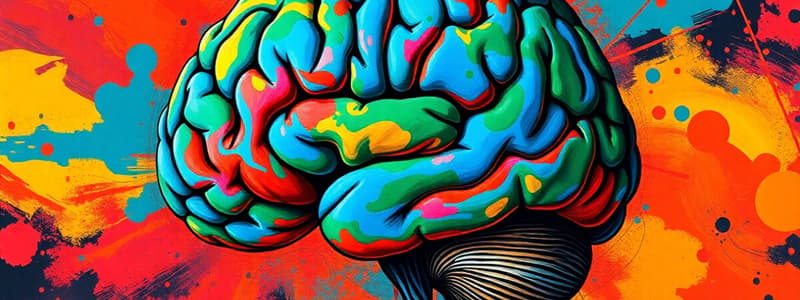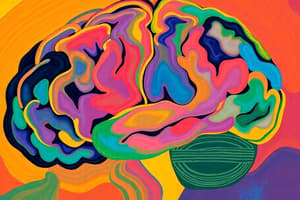Podcast
Questions and Answers
What is the primary function of the medulla in the brainstem?
What is the primary function of the medulla in the brainstem?
- Regulates heartbeat and breathing (correct)
- Modulates emotional responses
- Influences sleep and dreaming
- Controls balance and coordination
The cerebellum is responsible for regulating emotions.
The cerebellum is responsible for regulating emotions.
False (B)
Name one biological need that the hypothalamus regulates.
Name one biological need that the hypothalamus regulates.
Hunger
The ________ is known as the relay station for sensory information except for smell.
The ________ is known as the relay station for sensory information except for smell.
Which structure is part of the limbic system?
Which structure is part of the limbic system?
The reticular formation helps regulate sleep and attention.
The reticular formation helps regulate sleep and attention.
What is the primary role of the cerebellum in coordination?
What is the primary role of the cerebellum in coordination?
Match the following brain structures with their functions:
Match the following brain structures with their functions:
What is the primary role of the amygdala in the limbic system?
What is the primary role of the amygdala in the limbic system?
The hippocampus is essential for the formation of unconscious memories.
The hippocampus is essential for the formation of unconscious memories.
What does corticalization refer to?
What does corticalization refer to?
The ______ connects the two cerebral hemispheres, allowing for communication between them.
The ______ connects the two cerebral hemispheres, allowing for communication between them.
Match the following structures of the limbic system with their main functions:
Match the following structures of the limbic system with their main functions:
Which hemisphere of the brain is primarily associated with language production?
Which hemisphere of the brain is primarily associated with language production?
The right hemisphere specializes in visual-spatial perception.
The right hemisphere specializes in visual-spatial perception.
Name one function that the cerebral cortex is responsible for.
Name one function that the cerebral cortex is responsible for.
What is the primary function of the brainstem?
What is the primary function of the brainstem?
The cerebellum is primarily responsible for processing emotions.
The cerebellum is primarily responsible for processing emotions.
What role does the hypothalamus play in the nervous system?
What role does the hypothalamus play in the nervous system?
The ___________ is involved in processing sensory information before it reaches the cortex.
The ___________ is involved in processing sensory information before it reaches the cortex.
Which nervous system is responsible for the 'fight or flight' response?
Which nervous system is responsible for the 'fight or flight' response?
The limbic system is involved in emotion and memory processing.
The limbic system is involved in emotion and memory processing.
Match the following parts of the brain with their functions:
Match the following parts of the brain with their functions:
The ___________ nervous system conserves energy and counteracts the effects of stress.
The ___________ nervous system conserves energy and counteracts the effects of stress.
Flashcards are hidden until you start studying
Study Notes
The Hindbrain
- Comprises the brain stem and cerebellum.
- Essential for vital functions; damage can be life-threatening.
- Includes medulla, pons, reticular formation, and cerebellum.
Brain Stem
- Begins at spinal cord enlargement entering the skull.
- Most primitive brain part, vital for physical survival.
Medulla
- Oversees automatic functions: heartbeat, breathing, blood pressure, coughing, swallowing.
Pons
- Positioned above the medulla; influences body movement, sleep, and dreaming.
Reticular Formation
- Extends through the brain stem; crucial for attention and arousal.
- Screens incoming messages, controlling alertness during sleep.
Cerebellum
- Known as "little cerebrum"; consists of two hemispheres.
- Executes smooth, skilled movements; regulates muscle tone and posture.
- Alcohol can temporarily impair cerebellar function.
Forebrain
- Comprises thalamus, hypothalamus, limbic system, corpus callosum, and cerebrum.
Thalamus
- Functions as a relay station between lower and higher brain centers.
- Processes all sensory information except smell; regulates sleep cycles.
Hypothalamus
- Influential structure regulating basic biological needs: hunger, thirst, emotions.
- Acts as a "master regulator"; controls body temperature and autonomic nervous system.
Limbic System
- Combines structures like amygdala and hippocampus; crucial for emotion, memory, and motivation.
Amygdala
- Central to emotion, especially fear responses and recognizing fearful facial expressions.
Hippocampus
- Essential for forming conscious memories; involved in storing and recalling new information.
Cerebral Cortex
- Comprises two large hemispheres; responsible for higher cognitive functions like logic and language.
Corticalization
- Refers to the increased size and wrinkling of the cerebral cortex.
Corpus Callosum
- Band of nerve fibers connecting the two hemispheres, facilitating communication.
Cerebral Hemispheres: Lateralization
- Left hemisphere controls the right side of the body; specializes in language and speech production.
- Right hemisphere controls the left side; specializes in visual-spatial perception and nonverbal behavior.
The Nervous System
- Divided into the central nervous system (CNS) and peripheral nervous system (PNS).
- CNS includes the brain and spinal cord; PNS connects the CNS to the rest of the body.
Spinal Cord
- A cylindrical structure, essential for transmitting messages between the brain and PNS.
- Consists of neural tissue, glial cells, and is protected by bone and spinal fluid.
Peripheral Nervous System
- Consists of the somatic nervous system for sensory and motor functions, and autonomic nervous system for internal bodily regulation.
Autonomic Nervous System
- Contains sympathetic nervous system (activates "fight or flight" response) and parasympathetic nervous system (conserves energy, returns body to calm state).
Studying That Suits You
Use AI to generate personalized quizzes and flashcards to suit your learning preferences.




